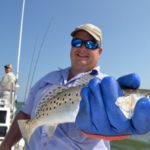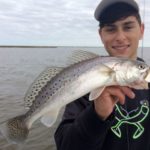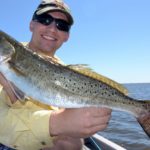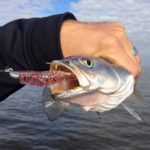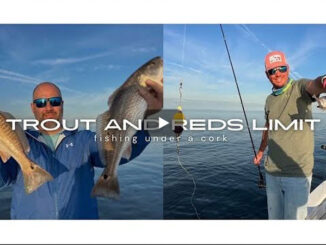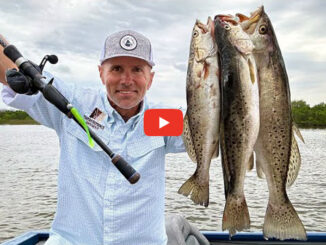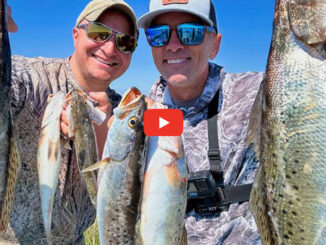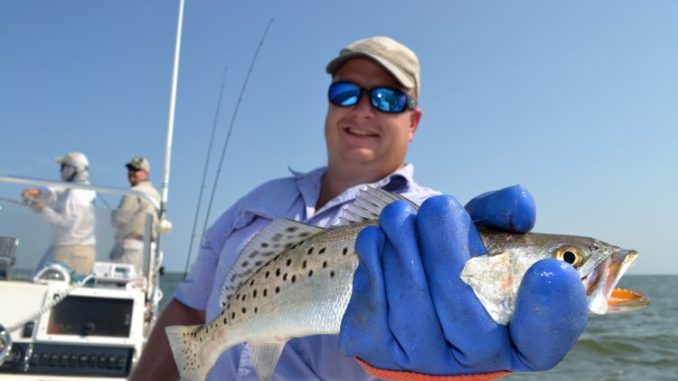
April isn’t the month to sit in one spot and hope trout come to you. Instead, it’s all about hitting as many spots as you can — and this guide knows shares the keys to his home waters of Dularge.
As many people in the older generation are quick to point out, kids these days are lazy.
Staring at and obsessing over iPhones, iPads, iMacs and other technologic items are causing people — even adults — to become unmotivated.
Laziness is rampant in America as a whole.
Unfortunately, being lazy has almost no advantages. You might feel like it’s fun when you’re chowing down on your fourth bag of Lays, but at the end of the day you have the personal satisfaction of getting a grand total of nothing productive accomplished.
Laziness isn’t good for fishermen, either.
Lazy anglers spend too much time in one spot, and it certainly doesn’t help them — particularly this month, said Capt. Travis Miller with Millertime Fishing Charters.
“The more you move in April, the better off you are,” Miller said. “It’s that time of year where you really get into that run-and-gun mode.”
The first thing with which anglers most likely have to deal in April is the exhaling of Mother Nature, the veteran guide said.
“It’s a really windy month, and a lot of the time it’s out of the southeast,” Miller said. “It’s a wind-based month. Everything is predicated on the wind — whether you’re going to have a great day, an average day or a (bad) day.”
Lakes inside the marsh hold trout in April across the coast, and that’s no exception in Dularge.
Miller focuses on sides of the lakes that don’t get affected by the wind as much, making not only the water clarity better but also easier to fish.
“I traditionally stick to the east or southeast side of all the lakes, whether you’re fishing Sister Lake or Lake Mechant,” he said. “You’re going to find most of your lake fish in there.”
These lakes can be very productive, but one of the most challenging parts is knowing where to fish in each body of water.
Miller said figuring it out in Dularge isn’t very difficult, thanks to a structure that often marks hotspots in the lakes.
“We have a lot of oyster poles, so if you don’t know the area at all, you can look for the poles and drift around them,” he said. “If you catch fish, mark it because that’s a reef you want to re-visit another day.
“Some reefs produce, and some don’t.”
He said he drifts in a lake until he catches a fish.
“I drift a lot, but I do drop the Power-Pole down when I stick a fish,” Miller said.
Although expensive, Power-Poles are worth their weight in a heavy ice chest. Having to put down a rope-tied anchor can really hurt efficiency, resulting in a meager haul.
“You definitely want to put the Power-Pole down to see if you can pick up a few really quickly,” Miller said. “Those fish are usually spread out, but you can find pockets of them.”
And, while he said the direction of the current doesn’t make a huge difference, but he does have a tidal preference. It all depends on where he’s fishing.
“Anytime I’m fishing in the marsh, I like a falling tide,” Miller said. “When I’m fishing offshore, I like an incoming tide.”
The presence of bait is usually common in the spring throughout the coast. But Miller said there’s been a lack of it the past few years.
“Out of the last five years, two or three of those we haven’t seen any shrimp,” Millwe said. “It used to be where you were guaranteed to see them, and you would always work birds in April, but the last couple years it seems like the shrimp population in April hasn’t shown up.”
However, oftentimes baitfish will replace those crustaceans, which makes it easier to locate those fish.
“There are times when we’ll find mullet up against the banks, and usually if you find those you want to stick with them,” he said. “The trout won’t be right in the mullet, but they’ll be on the edges of them.”
Dularge is known for double-rigging lures and anglers catching trout two at a time, but that’s rarely the case when fishing the marshes this month, the guide explained.
“A lot of times, they turn over to the cork in April,” Miller said.
Miller throws shrimp-creole colored Matrix Shads on ¼-ounce jigheads underneath Midcoast Products Texas Swing corks.
There’s nothing Miller likes better than calm days on the lakes, but truly flat-calm days in April are about as common as earthquakes in Louisiana.
When the winds blow strongly out of unfavorable directions, Miller implements a back-up plan that almost never fails.
“You can still find some trout back in the marsh, too,” he said. “If the wind is blowing really hard, you can (get protection) and put together a decent box.
“You’re not going to crush them inside the marsh, but there’s no reason why you can’t catch 25 or 30.”
Understanding where the fish are going and their biology can greatly increase success, he said.
“The fish are transitioning out of the marsh into the lakes in April,” Miller explained. “I fish those highways from the marsh to the lakes. That’s where you usually catch quite a few fish, especially in early April.”
And while those deep holes that held fish in the winter aren’t as productive this time of year, Miller doesn’t abandon them.
“You’re not fishing deep water anymore: You’re usually targeting those 2- to 4-foot areas,” he said. “If it’s really windy, you can get up where you would normally wintertime fish, but you don’t fish the deeper holes.
“You fish off of the deep holes on the flats.”
He always carries a certain color of lure when he’s fishing in the marsh, and he said it’s a must.
“If you’re going to fish the marsh, the green-hornet Matrix Shad is your best bait year-round,” Miller said.
But he also throws the limbo slice-colored Matrix Shad, all on ¼-ounce jigheads.
